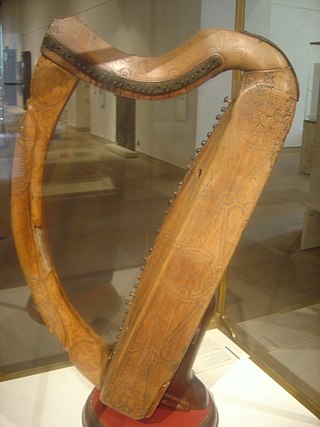Related Research Articles

Irish music is music that has been created in various genres on the island of Ireland.

Scotland is internationally known for its traditional music, which remained vibrant throughout the 20th century and into the 21st, when many traditional forms worldwide lost popularity to pop music. In spite of emigration and a well-developed connection to music imported from the rest of Europe and the United States, the music of Scotland has kept many of its traditional aspects; indeed, it has itself influenced many forms of music.
Piaras Feiritéar, or Pierce Ferriter, was an Irish clan Chief, and poet. Although best known for his many works of Bardic poetry in the Irish language, Feiritéar is also a widely revered folk hero in the Dingle Peninsula for his role as a leader of the nascent Irish Confederacy, which led to his 1653 summary execution at Killarney for resisting the Cromwellian conquest of Ireland.
Pibroch, piobaireachd or ceòl mòr is an art music genre associated primarily with the Scottish Highlands that is characterised by extended compositions with a melodic theme and elaborate formal variations. Strictly meaning 'piping' in Scottish Gaelic, piobaireachd has for some four centuries been music of the great Highland bagpipe.

The Celtic harp is a triangular frame harp traditional to the Celtic nations of northwest Europe. It is known as cláirseach in Irish, clàrsach in Scottish Gaelic, telenn in Breton and telyn in Welsh. In Ireland and Scotland, it was a wire-strung instrument requiring great skill and long practice to play, and was associated with the Gaelic ruling class. It appears on Irish coins, the coat of arms of the Republic of Ireland, Montserrat, Canada as well as the flag of Montserrat.
Celtic chant is the liturgical plainchant repertory of the Celtic rite of the Catholic Church performed in Britain, Ireland and Brittany. It is related to, but distinct from the Gregorian chant of the Sarum use of the Roman rite which officially supplanted it by the 12th century. Although no Celtic chant was notated, some traces of its musical style are believed to remain.
Ann Buckley is an Irish musicologist, born in Dublin.
Maol Ruanaidh Cam Ó Cearbhaill, otherwise An Giolla Caoch and Cam Ó Cearbhaill, sometimes anglicised as Cam O'Kayrwill was a notable Irish harpist and player of the tiompan, murdered with many others at the Braganstown Massacre.
Aed mac Donn Ó Sochlachain was Erenagh of Cong and an Irish musician.
Finn Ó Haughluinn, Irish musician, died 1490.
Aed Ó Finn was a 13th century Irish musician. His obituary, sub anno 1269, records that he was a "master of music and minstrelsy".
Mael Sechlainn Mac Carmaic, Irish musician, died 1330.
Gilla na Naem Ó Conmaigh, Irish musician, died 1360.
Muiris Ó Gibealláin, Irish jurist, singer, philosopher, poet and musician, died 1328.
Magrath Ó Fionnachta was an Irish musician.
Donell Dubh Ó Cathail [Daniel Duff O'Cahill] (c.1580–c.1660) was an Irish musician, a performer on the Irish harp.
Naisse mac Cithruadh, Irish musician, died 1561.

Music in Medieval Scotland includes all forms of musical production in what is now Scotland between the fifth century and the adoption of the Renaissance in the early sixteenth century. The sources for Scottish Medieval music are extremely limited. There are no major musical manuscripts for Scotland from before the twelfth century. There are occasional indications that there was a flourishing musical culture. Instruments included the cithara, tympanum, and chorus. Visual representations and written sources demonstrate the existence of harps in the Early Middle Ages and bagpipes and pipe organs in the Late Middle Ages. As in Ireland, there were probably filidh in Scotland, who acted as poets, musicians and historians. After this "de-gallicisation" of the Scottish court in the twelfth century, a less highly regarded order of bards took over the functions of the filidh and they would continue to act in a similar role in the Scottish Highlands and Islands into the eighteenth century.
Ferdomhnach Dall, Lector of Kildare and harpist, died 1110.
References
- Ann Buckley: "Musical Instruments in Ireland 9th–14th Centuries: A Review of the Organological Evidence", in: Musicology in Ireland (= Irish Musical Studies vol. 1), ed. G. Gillen & H. White (Blackrock, Co. Dublin: Irish Academic Press, 1990), pp. 13–57.
- Ann Buckley: "Music and Musicians in Medieval Irish Society", in: Early Music 28 (2000) 2, pp. 165–190.
- Ann Buckley: "Music in Prehistoric and Medieval Ireland", in: A New History of Ireland vol. 1, ed. Dáibhí Ó Cróinín (Oxford: Oxford University Press, 2005), pp. 744–813.